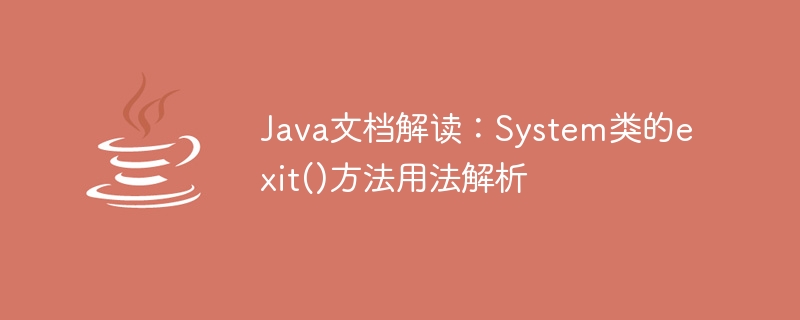

Interpretation of Java documentation: Usage analysis of the exit() method of the System class, specific code examples are required
The System class is an important class in Java, which provides many System-related functions and methods. Among them, the exit() method is a common method in the System class, which is used to terminate the currently running Java virtual machine. In this article, we will analyze the usage of the exit() method and give specific code examples.
The exit() method is defined as follows:
public static void exit(int status)
The exit() method receives an integer parameter status, indicating the exit status of the program. Generally speaking, when status is 0, it means that the program exits normally; when status is non-zero, it means that the program exits abnormally or with an error.
The following is a simple sample code:
public class ExitExample {
public static void main(String[] args) {
try {
// 模拟程序执行过程
System.out.println("程序开始执行...");
int result = divide(10, 0); // 调用除法方法会出现异常
System.out.println("程序执行结束,结果为:" + result);
} catch (Exception e) {
System.err.println("程序发生异常:" + e.getMessage());
System.exit(1); // 异常发生时,调用exit()方法退出程序
}
System.out.println("程序正常结束...");
}
public static int divide(int a, int b) {
return a / b; // 除以0,会抛出ArithmeticException异常
}
}In the above code, we deliberately set the divisor to 0 in the divide() method, thus triggering an ArithmeticException. In the catch block, we output the exception information through the System.err.println method and call System.exit(1) to exit the program. Parameter 1 here indicates that an error occurred in the program.
When the program is running, the console output is as follows:
程序开始执行... 程序发生异常:/ by zero
It can be seen that after the exception occurs, the program exits immediately and outputs the exception information. The code in the subsequent program will not be executed, that is, the program has no chance to continue execution, and the sentence "The program ends normally..." is output at the end.
It is worth noting that the System.exit() method will immediately interrupt the execution of the program, so the code after calling this method, even if it exists in the finally block, will not be executed. If you want to perform some cleanup before exiting, you can place this code before the exit method.
Summary:
The exit() method of the System class is the method used to exit the program in Java. It can receive an integer parameter to represent the exit status of the program. When the parameter is 0, it means the program exits normally; when the parameter is non-zero, it means the program exits abnormally or with an error. After calling the exit() method, the program will terminate execution immediately and subsequent code will not be executed. Therefore, if there are any cleanup operations that need to be performed before exiting, they need to be handled before calling the exit() method.
I hope the analysis and sample code in this article can help you understand the usage of the exit() method of the System class. If you have any questions, please feel free to discuss.
The above is the detailed content of Interpretation of Java documentation: Usage analysis of the exit() method of the System class. For more information, please follow other related articles on the PHP Chinese website!
